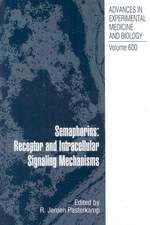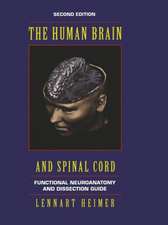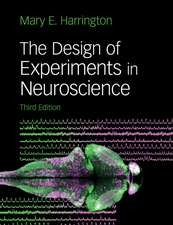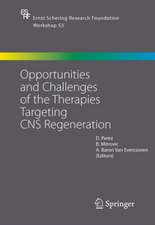Sensorimotor Integration in the Whisker System
Editat de Patrik Krieger, Alexander Grohen Limba Engleză Paperback – 22 oct 2016
In this book, authors examine the whisker system on many different levels, ranging from the building blocks and neuronal circuits to sensorimotor behavior. Neuronal coding strategies, comparative analysis as well as robotics illustrate the multiple facets of this research and its broad impact on fundamental questions about the neurobiology of the mammalian brain.
| Toate formatele și edițiile | Preț | Express |
|---|---|---|
| Paperback (1) | 640.06 lei 6-8 săpt. | |
| Springer – 22 oct 2016 | 640.06 lei 6-8 săpt. | |
| Hardback (1) | 646.30 lei 6-8 săpt. | |
| Springer – 10 sep 2015 | 646.30 lei 6-8 săpt. |
Preț: 640.06 lei
Preț vechi: 753.01 lei
-15% Nou
Puncte Express: 960
Preț estimativ în valută:
122.49€ • 127.41$ • 101.12£
122.49€ • 127.41$ • 101.12£
Carte tipărită la comandă
Livrare economică 14-28 aprilie
Preluare comenzi: 021 569.72.76
Specificații
ISBN-13: 9781493944446
ISBN-10: 1493944444
Pagini: 288
Ilustrații: IX, 276 p. 68 illus., 58 illus. in color.
Dimensiuni: 155 x 235 x 15 mm
Greutate: 0.41 kg
Ediția:Softcover reprint of the original 1st ed. 2015
Editura: Springer
Colecția Springer
Locul publicării:New York, NY, United States
ISBN-10: 1493944444
Pagini: 288
Ilustrații: IX, 276 p. 68 illus., 58 illus. in color.
Dimensiuni: 155 x 235 x 15 mm
Greutate: 0.41 kg
Ediția:Softcover reprint of the original 1st ed. 2015
Editura: Springer
Colecția Springer
Locul publicării:New York, NY, United States
Cuprins
Introduction.- Comparative Studies of Somatosensory Systems and Active Sensing.- The Whisker Thalamus.- Synaptic Microcircuits in the Barrel Cortex.- Imaging the Cortical Representation of Active Sensing in the Vibrissa System.- The Rodent Vibrissal System as a Model to Study Motor Cortex Function.- The Central Pattern Generator for Rhythmic Whisking.- Functional principles of Whisker-mediated Touch Perception.- Location Coding by the Whisking System.- The Robot Vibrissal System: Understanding Mammalian Sensorimotor Co-ordination through Biomimetrics.- Impact of Monoaminergic Neuromodulators on the Development of Sensorimotor Circuits.
Notă biografică
Patrik Krieger received his Ph.D. from Karolinska Institutet and then worked as a postdoctoral fellow with Bert Sakmann at the Max Planck Institute, Heidelberg. He is currently Head of the Department of Systems Neuroscience at the Ruhr-University Bochum. His research spans over both sensory and motor systems aiming to provide an understanding of how both systems interact during sensory-guided behavior. This research is done using a combination of electrophysiology and behavioural experiments where the activity of genetically labeled cell types has been modified to reveal the cell type specific contributions to sensorimotor integration. Furthermore, his research includes studies on the impact of sensory deprivation and cortical plasticity on tactile information processing. In addition he works on developing analytical tools for quantitative analysis of neuroanatomy.
Alexander Groh received his Ph.D. from the University of Heidelberg and worked as a postdoctoral fellow with Bert Sakmann at the Technische Universität München. His research focuses on the thalamocortical system, which he studies to understand cognitive functions, in particular sensory and motor processing. He is specifically interested in cortical feedback connections to the thalamus, and their role in controlling the flow of information through thalamocortical circuits. After characterizing the synaptic physiology and adaptation of corticothalamic "driver" pathways in the rat whisker system, he applied cell-type specific approaches to characterize the impact of cortical feedback pathways on sensory processing the thalamocortical system. He currently develops methods to explore the functions of corticothalamic interactions in behavior.
Alexander Groh received his Ph.D. from the University of Heidelberg and worked as a postdoctoral fellow with Bert Sakmann at the Technische Universität München. His research focuses on the thalamocortical system, which he studies to understand cognitive functions, in particular sensory and motor processing. He is specifically interested in cortical feedback connections to the thalamus, and their role in controlling the flow of information through thalamocortical circuits. After characterizing the synaptic physiology and adaptation of corticothalamic "driver" pathways in the rat whisker system, he applied cell-type specific approaches to characterize the impact of cortical feedback pathways on sensory processing the thalamocortical system. He currently develops methods to explore the functions of corticothalamic interactions in behavior.
Textul de pe ultima copertă
Sensorimotor integration, the dynamic process by which the sensory and motor systems communicate with each other, is crucial to humans’ and animals’ ability to explore and react to their environment. This book summarizes the main aspects of our current understanding of sensorimotor integration in 10 chapters written by leading scientists in this active and ever-growing field. This volume focuses on the whisker system, which is an exquisite model to experimentally approach sensorimotor integration in the mammalian brain.
In this book, authors examine the whisker system on many different levels, ranging from the building blocks and neuronal circuits to sensorimotor behavior. Neuronal coding strategies, comparative analysis as well as robotics illustrate the multiple facets of this research and its broad impact on fundamental questions about the neurobiology of the mammalian brain.
In this book, authors examine the whisker system on many different levels, ranging from the building blocks and neuronal circuits to sensorimotor behavior. Neuronal coding strategies, comparative analysis as well as robotics illustrate the multiple facets of this research and its broad impact on fundamental questions about the neurobiology of the mammalian brain.
Caracteristici
Provides a comprehensible overview of the latest knowledge on sensorimotor integration Shows how whisker system research can be used commercially in robotics and clinically as a test system of animal disease models Makes the findings of leading experts available to a wide audience Includes supplementary material: sn.pub/extras
























